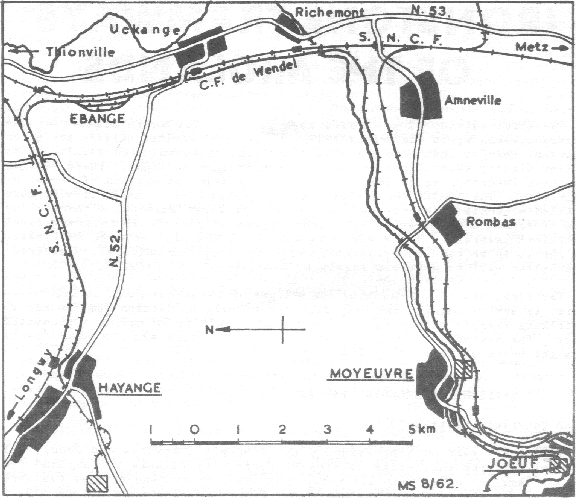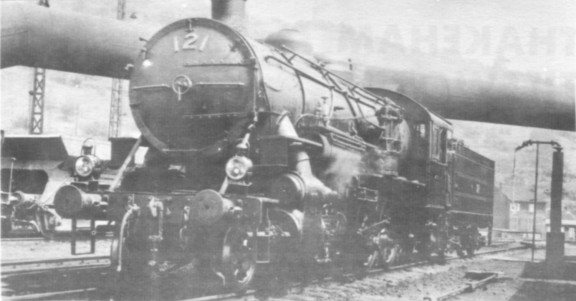
| THE INDUSTRIAL RAILWAY RECORD |
© NOVEMBER 1962 |
THE CHEMIN DE FER DE WENDEL
By NOEL A. NEEDLE
Forges were first established in the Fensch and Orne valleys of eastern France in the 13th and 14th centuries, and they came under the control of the de Wendel family in 1704. Today the Société Anonyme de Wendel owns one works in the Fensch valley at Hayange, and others in the Orne valley at Moyeuvre and Joeuf. The Chemin de Fer de Wendel, which is responsible for all rail transport in and between the three works, operates some 300 kilometres of track, 2500 wagons, 58 steam and 48 diesel locomotives. The railway system incorporates all the features of a main line railway with colour-light signalling, automatic level crossing gates, track laid to main line standards, and a large marshalling yard that requires the permanent services of two 0‑10‑0 tank locomotives. Before the French collieries were nationalised in May 1946, de Wendel had large mining interests near the Saar border and the locomotives that worked there were numbered in one list with the steelworks stock. The mines locomotives, 25 in all, were taken over by the Houillères du Bassin de Lorraine (Groupe de Petite Roselle) together with the mines.
The first recorded use of locomotives was in 1861 when two 0‑4‑0 tanks were obtained from Anjubault of Paris. Apart from these two, all the early locomotives up to 1907 were four- and six-coupled tanks supplied by Koechlin of Mulhouse and their successors, Société Alsacienne de Constructions Mécaniques (SACM) of Belfort and Graffenstaden. From 1907 to 1914 all new locomotives were obtained from the German firms Henschel and Borsig, and there was still nothing larger than the 0‑6‑0 tank. The first locomotives to be purchased after the 1914-1918 War were six standard Schneider 0‑6‑0 tanks, but these were the only ones from this firm, and in 1924 a return was made to SACM with an order for several 0‑8‑0 tanks. Other 0‑6‑0 tanks and 0‑8‑0 tanks followed from SACM at intervals up to 1930, and the two 0‑10‑0 tanks for the marshalling yard date from this period too. 1929 saw a return to German builders for a year or two with the purchase of several 0‑6‑0 tanks from Henschel and 0‑8‑0 tanks from Borsig. No more new locomotives were then purchased until 1946 when four standard 0‑6‑0 tanks arrived from SACM. Several more followed up to 1949, and the last new steam locomotive was an 0‑8‑0 tank from the same firm in 1953. Meantime several locomotives had been obtained second-hand from various sources and these included 0‑4‑0, 0‑6‑0, 2‑6‑0, and 0‑8‑0 tanks by a variety of German builders, and also several of the well-known Baldwin 2‑8‑0 tender engines that had been built for service in the 1914-1918 War. The latter locomotives were acquired both from the Alsace Lorraine Railways, and the SNCF, for working trains between the works at Hayange and Moyeuvre and the marshalling yard at Ebange, and for service at the mines. Five of them still survive at the steelworks, and there may well be others still in service at the mines. The diesels comprise various types with hydraulic or electric drive, and the majority were supplied by SACM. Most of these diesels have been obtained since 1954 and at the moment are not replacing steam locomotives to any great extent owing to the enormous increase in traffic. However, more diesels are on order and they will soon be in sufficient numbers to enable the steam stock to be replaced.

In June 1961, the oldest locomotive still in service was 68, an 0‑4‑0 well tank built by Borsig in 1906. This is kept for a special job at Moyeuvre Works together with a similar engine, 69, built by Borsig in 1908. These are the only 0‑4‑0 tanks remaining with de Wendel; indeed, four-coupled locomotives are something of a rarity throughout France as far as the standard gauge is concerned. All the steam locomotives are well cared for and look extremely smart in their livery of black, relieved by raised brass numerals on the tank or tender sides, and with polished brass boiler bands. The diesels are painted green and they too have the raised brass numerals on the cabsides. There is a locomotive depot at each of the three works, and a large central workshops at Hayange where all heavy repairs and overhauls are carried out.
The present, and most of the past, locomotive stock is well documented but one or two points remain mysteries. The Cockerill works list records the delivery in 1906, 1907 and 1908 of four vertical boiler 0‑4‑0 tank locomotives, but neither the de Wendel numbers nor the gauge are known. Various other works lists record deliveries of locomotives of 645mm and 750mm gauges, but no trace of these narrow gauge systems now remain. Positive information on these obscure points would be welcomed.
The following picture was actually carried over and printed in issue No.2, but is shown here for convenience:

Chemin de Fer de Wendal 121 (Baldwin 48987 of 1918), 20th July 1953. (J.D. Blyth)